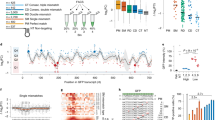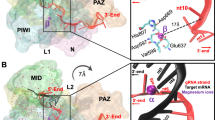Abstract
Small-interfering RNAs (siRNAs) assemble into RISC, the RNA-induced silencing complex, which cleaves complementary mRNAs. Despite their fluctuating efficacy, siRNAs are widely used to assess gene function. Although this limitation could be ascribed, in part, to variations in the assembly and activation of RISC, downstream events in the RNA interference (RNAi) pathway, such as target site accessibility, have so far not been investigated extensively. In this study we present a comprehensive analysis of target RNA structure effects on RNAi by computing the accessibility of the target site for interaction with the siRNA. Based on our observations, we developed a novel siRNA design tool, RNAxs, by combining known siRNA functionality criteria with target site accessibility. We calibrated our method on two data sets comprising 573 siRNAs for 38 genes, and tested it on an independent set of 360 siRNAs targeting four additional genes. Overall, RNAxs proves to be a robust siRNA selection tool that substantially improves the prediction of highly efficient siRNAs.
This is a preview of subscription content, access via your institution
Access options
Subscribe to this journal
Receive 12 print issues and online access
$209.00 per year
only $17.42 per issue
Buy this article
- Purchase on Springer Link
- Instant access to full article PDF
Prices may be subject to local taxes which are calculated during checkout



Similar content being viewed by others
Accession codes
References
Tomari, Y. & Zamore, P.D. Perspective: machines for RNAi. Genes Dev. 19, 517–529 (2005).
Meister, G. & Tuschl, T. Mechanisms of gene silencing by double-stranded RNA. Nature 431, 343–349 (2004).
Ameres, S.L., Martinez, J. & Schroeder, R. Molecular basis for target RNA recognition and cleavage by human RISC. Cell 130, 101–112 (2007).
Bernhart, S.H., Hofacker, I.L. & Stadler, P.F. Local RNA base pairing probabilities in large sequences. Bioinformatics 22, 614–615 (2006).
Ding, Y. & Lawrence, C.E. Statistical prediction of single-stranded regions in RNA secondary structure and application to predicting effective antisense target sites and beyond. Nucleic Acids Res. 29, 1034–1046 (2001).
Huesken, D. et al. Design of a genome-wide siRNA library using an artificial neural network. Nat. Biotechnol. 23, 995–1001 (2005).
Takyar, S., Hickerson, R.P. & Noller, H.F. mRNA helicase activity of the ribosome. Cell 120, 49–58 (2005).
Doshi, K.J., Cannone, J.J., Cobaugh, C.W. & Gutell, R.R. Evaluation of the suitability of free-energy minimization using nearest-neighbor energy parameters for RNA secondary structure prediction. BMC Bioinformatics 5, 105 (2004).
Haley, B. & Zamore, P.D. Kinetic analysis of the RNAi enzyme complex. Nat. Struct. Mol. Biol. 11, 599–606 (2004).
Brennecke, J., Stark, A., Russell, R.B. & Cohen, S.M. Principles of microRNA-target recognition. PLoS Biol. 3, e85 (2005).
Doench, J.G. & Sharp, P.A. Specificity of microRNA target selection in translational repression. Genes Dev. 18, 504–511 (2004).
Jackson, A.L. et al. Expression profiling reveals off-target gene regulation by RNAi. Nat. Biotechnol. 21, 635–637 (2003).
Lai, E.C. Micro RNAs are complementary to 3′ UTR sequence motifs that mediate negative post-transcriptional regulation. Nat. Genet. 30, 363–364 (2002).
Reynolds, A. et al. Rational siRNA design for RNA interference. Nat. Biotechnol. 22, 326–330 (2004).
Schwarz, D.S. et al. Asymmetry in the assembly of the RNAi enzyme complex. Cell 115, 199–208 (2003).
Khvorova, A., Reynolds, A. & Jayasena, S.D. Functional siRNAs and miRNAs exhibit strand bias. Cell 115, 209–216 (2003).
Patzel, V. et al. Design of siRNAs producing unstructured guide-RNAs results in improved RNA interference efficiency. Nat. Biotechnol. 23, 1440–1444 (2005).
Ding, Y. & Lawrence, C.E. A statistical sampling algorithm for RNA secondary structure prediction. Nucleic Acids Res. 31, 7280–7301 (2003).
Yu, Y. & Sato, J.D. MAP kinases, phosphatidylinositol 3-kinase, and p70 S6 kinase mediate the mitogenic response of human endothelial cells to vascular endothelial growth factor. J. Cell. Physiol. 178, 235–246 (1999).
Ladunga, I. More complete gene silencing by fewer siRNAs: transparent optimized design and biophysical signature. Nucleic Acids Res. 35, 433–440 (2007).
Lu, Z. & Mathews, D.H. Efficient siRNA selection using hybridization dynamic. Nucleic Acids Res. 36, 640–647 (2008).
Acknowledgements
We would like to thank A. Khvorova for critical discussions during the project as well as Dharmacon Inc. for providing siRNA knockdown data. H.T. is supported by Siemens and the Wiener Wissenschafts-, Technologie-, und Forschungsfonds. S.L.A. is funded by the Austrian Science Fund FWF through WK001. J.M. is a Junior Group Leader at IMBA, the Institute of Molecular Biotechnology supported by the Austrian Academy of Sciences. Funding by the Austrian Government's GEN-AU is acknowledged by R.S., J.M. and I.L.H. We thank the members of the Hofacker, Schroeder and Martinez labs for encouragement, helpful discussions and comments on the manuscript.
Author information
Authors and Affiliations
Contributions
H.T., S.L.A. and G.O. initiated research, designed and performed the experiments and analyzed data. I.L.H. designed algorithms, supervised implementation and analysis. C.A.G. performed western blot analysis. R.S. supervised experimental work and analysis. J.M. supervised experimental work and analysis and procured access to the Dharmacon data. All authors contributed to the writing of the manuscript.
Corresponding authors
Supplementary information
Supplementary Text and Figures
Supplementary Figures 1–7, Tables 1–4 (PDF 1299 kb)
Rights and permissions
About this article
Cite this article
Tafer, H., Ameres, S., Obernosterer, G. et al. The impact of target site accessibility on the design of effective siRNAs. Nat Biotechnol 26, 578–583 (2008). https://doi.org/10.1038/nbt1404
Received:
Accepted:
Published:
Issue Date:
DOI: https://doi.org/10.1038/nbt1404
This article is cited by
-
From a genome-wide screen of RNAi molecules against SARS-CoV-2 to a validated broad-spectrum and potent prophylaxis
Communications Biology (2023)
-
Design of siRNA molecules for silencing of membrane glycoprotein, nucleocapsid phosphoprotein, and surface glycoprotein genes of SARS-CoV2
Journal of Genetic Engineering and Biotechnology (2022)
-
Secondary structure prediction for RNA sequences including N6-methyladenosine
Nature Communications (2022)
-
Chemical engineering of therapeutic siRNAs for allele-specific gene silencing in Huntington’s disease models
Nature Communications (2022)
-
Therapeutic siRNA: State-of-the-Art and Future Perspectives
BioDrugs (2022)



